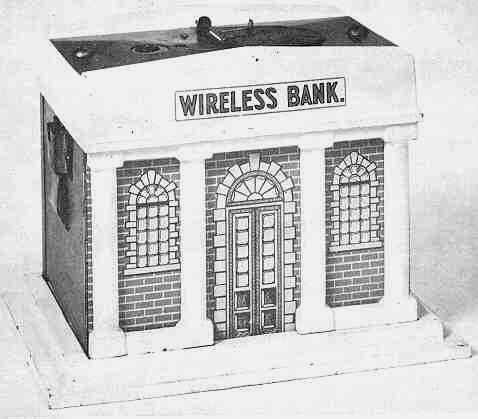The Wireless Bank
by F.H. Griffith - HOBBIES Magazine - September, 1975

A mechanical with unusually interesting action is our choice as No. 253 in the numerical classification. This is the Wireless Bank having a somewhat unique operation insofar as mechanical banks are concerned. It is a well made attractive bank type of building constructed of cast iron, tin, wood, copper, and incorporates the use of a coil magnet and a D size battery.
The inventor of this rather complicated bank was Christian Berger of New York City, and he assigned his patent to Frederick I. Sawyer of Evanston, Ill. The patent is dated January 5, 1926 and consists of four drawings of the bank with three pages of text. The drawings are identical to the bank as manufactured, even showing the name ‘Wireless Bank’. The text is unusually detailed and explicit, covering the bank from all angles. Initially, Mr. Berger states in the patent that ‘A purpose of the invention is to afford an operable depositing device by which the coin may be thrown, flipped, released or otherwise deposited in the receptacle in a novel and effective manner’.
A particular purpose is to bring about the depositing action by control from a distance, for example by wave control, sound waves being herein shown as a suitable embodiment of the invention. Mr. Berger further covered an important point with respect to the circuit: ‘Before further describing the circuit I will state that I prefer to include in the circuit the magnet core and the depositor flap so that the circuit will be broken and current saved except when the depositor has been set in contact with the magnet, and this arrangement further renders the apparatus more sensitive and reliable.’ This, of course, covered the possibility of a battery being left in the bank for a length of time with no drain of current from the battery taking place. Irrespective of this, it is not a good idea to leave a battery in the bank for any long period of time.
The bank shown is in excellent all original condition and the colors of the building are as follows: The cast iron base, front columns, and roof section are white and the name thereon is gold outlined in black. The front, right side (as pictured), and back are lithographed tin simulating red brick-work. The front entrance and two windows are gray with the defined stonework and window panes in a darker gray. The left end of the building is wood, stained red. The inserted tin top section of the roof is green, and this completes the coloring of a very attractive bank.
Before operating the bank it is necessary, of course, to insert a battery in the provided section in the underside. The flap on the top of the roof is then pulled over into position on the magnet where it stays in place. A coin is placed on the flap. Stepping back several feet from the bank, a loud clap of the hands or a strong call of the word ‘cash’ causes the mechanism to operate and the flap swings over depositing the coin in the bank. A very nice action mechanical and interesting to show to those not familiar with its mechanism and basis of operation.
Now to a puzzling or semi-mystery type of thing. The front underside edge of the cast iron base has the following inscribed thereon: ‘Pat. March 11, 1913 — Nov. 10, 1914 — Dec. 19, 1916 — Sept. 24, 1918.’ So far the writer has not found any of these patents. They must exist and time and further searching may bring them to light. The patent date of January 5, 1926 does not appear on the writer’s example of this bank, nor on a number of others he has examined. It is highly likely the four patent dates of 1913, 1914, 1916, and 1918 do not necessarily have to do with a mechanical bank, but rather some phase of an operating principle. Assuming this to be the case, the bank could have been manufactured some years prior to 1926 since this date is not on the bank, covered in part then by the four patent dates shown. Then a decision made to apply for a patent covering the mechanical bank as such with the application filed June 9, 1922 and finally issued June 5, 1926.
